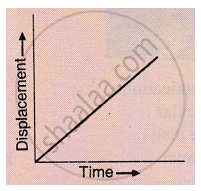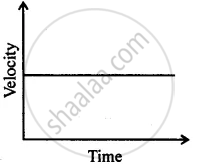Advertisements
Advertisements
प्रश्न
A train starting from stationary position and moving with uniform acceleration attains a speed of 36 km per hour in 10 minutes. Find its acceleration.
उत्तर
Initial velocity, u=0m/s
Final velocity, v=36km/h=10m/s
Time, t=10min =10 x 60=600 sec
Average velocity =
`"Inition velocity + Final velocity"/"2"`
Thats is, Average velocity= `(u+v)/2`
Also, Distance travelled= Average velocity ×Time
so, s=`((u+v))/2` × t ...............(1)
Form the first equation of motion, we have, v =u+at.
put this value of v in equation (1), we get:
s =`((u+u+at))/2 × t`
or s=`((2u+at)×t)/2`
or s = `(2ut+at^2)/2`
or s = `ut + 1/2 at^2`
where, s =distance travelledby the boby in time t
u= initial velocity of the body
and a= acceleration
Acceleration = `"Final velocity - Initial velocity"/"time taken"`
so, a= `(v-u)/t=( 10-0)/600 =10/600"m//s^2 =1/60m//s^s = 0.016m//s^2`
APPEARS IN
संबंधित प्रश्न
When will you say a body is at non-uniform acceleration?
Give one example of a situation in which a body has a certain average speed but its average velocity is zero.
Fill in the following blank with suitable word :
A motorcycle has a steady……………. of 3 m/s2. This means that every………………. its…………….. increases by………….
What conclusion can you draw about the velocity of a body from the displacement-time graph shown below :

A cheetah starts from, rest, and accelerates at 2 m/s2 for 10 seconds. Calculate :
(a) the final velocity
(b) the distance travelled.
When is the negative acceleration?
How can you find the following?
Acceleration from velocity – time graph.
Can you suggest a real-life example about the motion of a body from the following velocity – time graph?

A body is thrown vertically upward with velocity u, the greatest height h to which it will rise is,
An electron moving with a velocity of 5 × 104 ms−1 enters into a uniform electric field and acquires a uniform acceleration of 104 ms–2 in the direction of its initial motion.
(i) Calculate the time in which the electron would acquire a velocity double of its initial velocity.
(ii) How much distance the electron would cover at this time?
